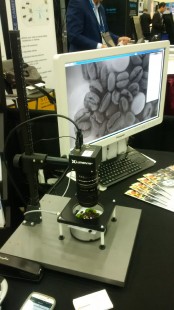This week, Lumenera is at the SPIE Defense + Commercial Sensing (SPIE DCS) show demonstrating our Lt16059HM, a USB 3.0 industrial grade 16 MP CCD large format monochrome camera with Canon lens and a visible light blocking filter. Using an 850 nm NIR light ring we will be demonstrating how the camera can help differentiate organic vs inorganic matter in inspection applications. The detail and sensitivity at this wavelength is a result of our superior camera design that does not contain infrared filters, anti-aliasing filters or data altering firmware commonly found consumer camera systems. (Pictured Left: Lumenera’s demo at SPIE DCS using the Lt16059HM camera and a NIR light ring targeting targeting coffee beans and herbs. Click here for larger image.)
The implementation of this particular lighting and filtering setup is ideal in environments with complex lighting. When certain objects are exposed to NIR light, they will reflect a distinct signature of light based on their composition. This allows for certain types of image analysis, such as food inspection and precision agriculture (NDVI) due to the fact that healthy organic material will reflect more IR light than unhealthy, dead, or inorganic matter. These methods can also be used to inspect fruits and vegetables for damage such as bruising. When produce is deformed, water takes the place of the organic matter. Since NIR light is absorbed by water, the bruised areas show up with much higher contrast as dark spots in an NIR image.
Further industrial applications of NIR include infrared reflectography, used to study antique paintings. Since NIR light can penetrate deeper into certain pigments than visible light, it can be used to authenticate paintings as well as study the artistic process by viewing previously sketched or painted drafts on the canvas. In the Intelligent Traffic Systems domain, NIR imaging can be used in conjunction with infrared illumination to perform low light image capture at night without distracting motorists with bright flashing visible light. NIR flashes can be brighter than their visible light counterparts as they are invisible to the human eye and will produce brighter images with clearer detail.
Additionally, this configuration can be used in numerous life sciences applications. New cutting edge technology being tested by the Australian Red Cross Blood Services uses NIR to see under a patient’s skin to find their veins. Similarly to water, blood also absorbs NIR light. This allows the device to see the NIR absorption patterns created by blood in the patient’s veins. It then records and projects a live image on to the scanned area so that medical personnel can easily locate veins in poor lighting conditions or through damaged skin. Infrared spectroscopy is another application where a patient’s skin is subjected to NIR light – in this case, to determine the health and hydration of the skin. Future uses of NIR imaging could see non-invasive mapping of skin cancer as research is allowing for the detection of latent signs of skin disorders with the use of NIR sensitive cameras.


